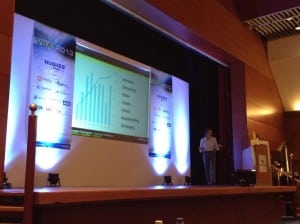Latest News

Simon Bull of Comsys kicks off VSAT2013 taking about the state of the global VSAT industry.
Image credit: VSAT 2013
[Amsterdam 09-18-13] The VSAT market is in surprisingly good shape and showed good growth in 2012. This was the view of Simon Bull, senior consultant at Comsys, who kicked off VSAT 2013 with an upbeat presentation about the state of the VSAT market. Bull said terminal sales grew to 345,000 in 2012, up 16 percent compared to the previous year, and that 2013 also looks “encouraging.” In 2012, sites in service also went up 5 percent to 1.7 million globally in 2012, as well as consumer subscribers growing 10 percent last year as well, he said.
However, Bull said VSAT players were operating in a changing world. Growth is different, and the way in which it is happening is changing, he said. “Demand is rarely exponential or linear,” he said.
While the VSAT market was characterized by “ups and downs,” Bull said many particular segments are showing good growth. “The SCADA market is one to watch. It is a sector driving demand. It has a pretty good growth curve. We have seen more service go into this area,” he said. “The banking/ATM market also has a nice growth curve. India and Brazil have seen huge growth in this area. Banks are buying VSAT services because they want reliability and coverage. In the carrier/telecom part of the market, 2012 annual growth was around 22.8 percent. Carriers are using more VSAT today.”
Bull presented a state of the union of the VSAT market in all key regions of the world. In North America, he described the market as “mature, polarized, consolidated, hybridized, marginalized, etc.” and that it remains one of the most innovative markets around. “There are a couple of big operators and a lot of small operators. It is moving to a hybridized solution, so you see Hughes Networks Systems and Spacenet, both offering combined satellite and terrestrial services. But, I do see VSAT being pushed to the edge here, hence using the term ‘marginalized,’” he said.
For Latin America, Bull said sales were up and down and that it was still “a very political market.”
“National markets such as Venezuela and Argentina remain tough places to do business. Governments drive a lot of what is happening,” he added. “We see a good market in Colombia and Brazil. Markets are driven on a national basis, however, they accept the capabilities and solutions that VSAT solutions bring, which is a good sign.”
Bull described Europe, one of the world’s major markets, as “strange,” but also “pivotal.” There is still an ongoing hostility toward VSAT services, according to Bull. “There is a lot of hostility toward satellite communications in Europe. Customers and carriers don’t want to accept satellite. Satellite is not considered to be a core service. There are places in Europe where it makes perfect sense to deploy VSAT, but it isn’t being deployed. Eastern Europe can be different. Russia has been a pretty good market, pretty consistent, for example,” he said.
Asia, with its huge country markets, had many successful stories for VSAT, with Bull describing India as the most innovative VSAT market globally, growing at tens of thousands of VSATs per year, but then describing Philippines as a “terrible” market for VSAT services. He said the mining boom in Australia had been “massive,” and also highlighted Indonesia as another strong market in the region. Thus, according to bull, Asia is a market characterized by huge opportunities for VSAT.
Assessing the African VSAT market, however, is harder to analyze. Bull said that with a lot of fiber coming into the market, growth had slowed down. “The amount of sales in 2011 actually halved compared to 2010. The market is volatile and fertile,” he said. “Nigeria is a place you love to hate, for example. It is very entrepreneurial, but not an easy place to do business. People are coming back to VSAT now in the region.”
During the second presentation of the day at VSAT 2013, Adrian Morris, CTO, Hughes Networks Systems, said the satellite broadband market is expanding to markets such as consumer, SME, enterprise and government. “In North America, we are seeing the video and data combination enhancing the satellite broadband market. Ka-band is accelerating the demand for broadband. We are seeing more capacity and lower cost per bit,” he sai.d
In terms of the potential for Q- and V-band, Morris said, “There is still a good availability of orbital slots of Ka-band, so I think you will see a lot of activity here over the next three to five years. The problem [for Q and V-band] is that the technology is in its infancy, I think it will be five to 10 years before you see developments.”
Get the latest Via Satellite news!
Subscribe Now